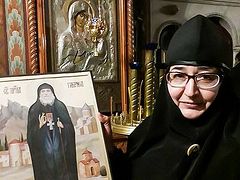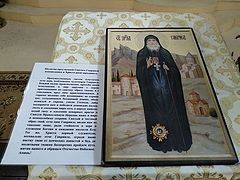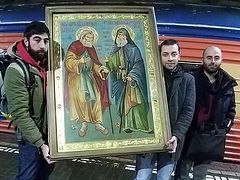We first met with Tamuna Gochiashvili two years ago, right after our creative team had received the blessing of His Holiness Catholicos-Patriarch Ilia II of All Georgia to paint the icon, “Unity in Christ and the Friendship Between the Russian and the Georgian Orthodox Nations”. This icon depicts two great saints—Gabriel of Samtavro and Seraphim of Sarov. We have already published articles on the miracles performed in front of this icon and testimonies of people who have experienced the mercy of God, having been strengthened and received healing through the venerable fathers’ prayers. And then Tamuna painted the icon, “The Glory of the Most Holy Trinity”. We have talked about these icons and the unique story of their creation.
 Sts. Seraphim of Sarov and Gabriel (Urgebadze) as symbols of Russian-Georgian friendship —Tamuna, can you tell us a little about your profession?
Sts. Seraphim of Sarov and Gabriel (Urgebadze) as symbols of Russian-Georgian friendship —Tamuna, can you tell us a little about your profession?
—After graduating from the State Academy of Arts I studied at the Department of Medicine. Our family had rich medical traditions, and everybody believed that I would embark on this career too; but, as we know, man proposes and God disposes. Thus, my interest in and passion for art and painting prevailed over everything else related to other professions. I graduated from the Department of Fine arts where I studied the restoration of frescoes. I should note that iconography is an interdisciplinary sphere; and it is not only the technique, style or mood. In order to paint an icon you need to have good knowledge of theology, take into consideration certain historical contexts and many other nuances which are of great importance in this service. I believe that icon-painting is not just a profession: it is a kind of service, obedience and the grace of God. I have been doing this for over twenty-five years.
—We are aware that you knew Elder Gabriel (Urgebadze) very well. Before we proceed to the subject of the story of these icons, please tell us what memories St. Gabriel left of himself?
—Yes, I knew Fr. Gabriel well. I remember him as a very simple, humble and wise person. His distinctive attribute was ingenuousness in communication with people, a unique approach to every individual person. He never spoke in a haughty manner with those who came to him humiliated, insulted and weighed down with sins. He would often pose as a great sinner before of such people, pretending he had just committed a serious sin, speaking about this loudly with tears in his eyes. And, seemingly quietly and imperceptibly, he brought home to people that they should repent, they shouldn’t abandon God, that the Lord waits for our repentance with such power that all his visitors would soon feel drawn to God, to the Church, find consolation, and after communicating with the elder leave him inspired by the grace of the Holy Spirit. Another attractive attribute of Elder Gabriel was a sense of humor. Through humor he could humble and bring someone to his senses to such an extent that their vanity disappeared immediately, and everybody began to feel ineffable joy instead of the discomfort that all of us feel when reproached.
—Did he humble you?
—He did. I remember myself and my friend, another iconographer, coming to Elder Gabriel in Samtavro. While we were talking, darkness fell. At that time there was no electricity, no gas, no public transportation in Georgia; subway trains often stopped due to lack of electricity, and people couldn’t drive their cars. We wanted to stay at the convent without telling the elder about our desire—we waited for his invitation. Soon Fr. Gabriel indeed suggested we stay over at the convent. I was happy, thinking proudly: “I will stay with the nuns, and my friend will stay with the elder. Though Fr. Gabriel speaks harshly to some, he has allowed us to stay at the convent; after all, we are icon-painters!” As soon as I thought this, the elder looked at me and said: “Yes, I’ve decided you both will stay here. Let one of you lie down in a coffin to sleep, and the other—in the coffin lid!” Having imagined that we would have to sleep in a coffin, we both got terrified, ran out of the elder’s cell at lightning speed and darted towards Tbilisi, while the elder’s loud laughter and shouting followed us: “My coffin is good and polished! Why are you running away?” When we met with Fr. Gabriel the next time, he asked us very expressively: “Have you ever been on high-speed transportion like the one when you ran away that day?”
—Do you feel Elder Gabriel’s help and support in your service?
—Not only do I feel his support, I even sense his living presence. I personally regard him as my heavenly spiritual father and instructor. When I started working on the icon, “Unity in Christ and the Friendship Between the Russian and the Georgian Orthodox Nations”, I realized it was a great responsibility. One day, while working, I even felt and heard Fr. Gabriel’s presence keenly. He entered my workshop, looked at me and said with a smile: “Well, let’s have a look.” I understood that sign as some kind of warning and obedience. I knew the elder was near and controlled my work. I finished the icon, my husband put a metal covering on it, and we took it to Tbilisi.
The next day, together with our creative team we went to Samtavro Convent to have our icon blessed. By miracle our work on the icon was completed the day before Fr. Gabriel’s birthday, and on August 26 (his birthday) it was brought for blessing.
My heart was beating in an unusual way: I wondered how the Samtavro nuns, the saint’s spiritual daughters, would think of the icon and what they would say. My joy and amazement were boundless when the nuns began to smile after looking at the icon; some even shed a few tears. After the service they recounted: “Fr. Gabriel used to say as if jokingly: ‘The day will come when you see that somewhere I am slightly taller than St. Seraphim of Sarov.’ And he laughed. We thought he was joking or meant something else; but now that we see the icon we recall his words. This is what he meant!” On the icon St. Gabriel is slightly taller than St. Seraphim. If it were not for Fr. Gabriel’s blessing, support and the striking fulfilment of this prophecy (of which I hadn’t known before), how would I have painted the icon? And on the icon his height is slightly greater than that of our beloved Fr. Seraphim.
—Thus the elder let you know that he was pleased with the icon?
—I think so. It is in his nature to encourage, inspire and comfort in this way.
Painting every single icon is a spiritual struggle against yourself, your sinful nature and pride. Every time you are creating an icon of one or another saint you think whether the saint will be pleased with it, whether he is blessing you, what you should pay attention to after finishing it, and what you should correct and learn.
I recall another case of his help when I was working on the icon, “The Glory of the Most Holy Trinity”. That icon depicts St. Spyridon of Tremithus and Elder Gabriel. As is generally known, one of the most significant events of the First Oecumenical Council of 325 was the speech of St. Spyridon, who exposed the heresy of Arius, which argued that Christ was created by God the Father and was not equal to Him. Many philosophers were on the side of Arius and by false logical inferences tried to reject the arguments in favor of the Triune God. It seemed the argument was nearing deadlock… But St. Spyridon of Tremithus demonstrated the unity of the Holy Trinity for everybody to see. He took a brick into his hands, squeezed it—and in an instant fire shot out of it, water dripped on the ground, and clay remained in the saint’s hands. “There are three elements of which one brick is composed. Likewise, in the Holy Trinity there are Three Persons but only One God,” the wonderworker proclaimed.
There was a similar episode in the life of Elder Gabriel. It was testified to by Archimandrite Kirion (Oniani). Once some Hindus who were visiting the elder asked him, “Fr. Gabriel, what will you answer if we say that you Christians are mistaken? Though you Orthodox adopted the idea of the Trinity from us, you misunderstood the teaching of Brahma, Vishnu and Shiva; the Hindu triad, despite the harmonic connection, has no unity, whereas you consider the Trinity as triune, which is a basic mistake.”
Fr. Gabriel replied: “You are wrong! Our teaching is Divine, otherworldly and came from the Lord. How can there be any mistake here? But, since you don’t believe this and are so self-confident, I will also answer with a demonstrative example.” Fr. Gabriel took bread from a pan, put it on a tray and said: “You see: the bread is one and undivided!” Then in the Name of the Most Holy Trinity he made the sign of the cross over the bread—and water, fire and wheat appeared in its place! Then Fr. Gabriel addressed the Hindus, who were dumbstruck at the sight, “Look attentively! Water, fire and wheat have appeared instead of bread. Likewise, the Holy Trinity is divided into Three Persons: the Father, the Son, and the Holy Spirit.” Next in the Name of the Holy Trinity he made the sign of the cross over the water, fire and wheat—and they turned into bread again. After that the elder said: “The Most Holy Trinity is One and Undivided just as this bread is one and undivided!”
After I had started working on this icon, one day my five-year-old son Andria came into my workshop and, as usual, wondered who I was “drawing”. I replied I was painting an icon of Sts. Spyridon and Gabriel. He looked at the image and asked naively with a child’s smile, “And why were Elder Gabriel’s ears of wheat consumed by fire?!” I was speechless with surprise. I hadn’t yet depicted tongues of flame rising from the ears of wheat, but my son could already see them! Here is the grace of the Holy Spirit, along with a sign of Elder Gabriel’s blessing.
 —We know that in light of the current epidemic, several days ago you finished another extraordinary icon. Please, tell us about it.
—We know that in light of the current epidemic, several days ago you finished another extraordinary icon. Please, tell us about it.
—The idea of painting this icon was conceived immediately, at the very outbreak of the new pandemic. Our world has seen very many epidemics, but we decided to choose some saints who either served during one or another epidemic or are venerated as protectors of people and the world against deadly pestilences. And we found a large number of such saints who lived both in the East and in the West. I should confess it was hard to single out one specific saint, so in the end we chose fifteen saints. The icon was painted with the desire to express our gratitude and support to doctors struggling against COVID-19 so that these holy men could be their intercessors and patrons in epidemiological and medical matters.
—Which saints are depicted on the icon?
—The main saint on the icon is St. Gregory the Great, the Pope of Rome, holding an icon of the Holy Theotokos in his hands. The icon is called “The Protectress of the Roman People” and reflects a well-known fact. When during a raging pestilence St. Gregory carried the holy icon of the Mother of God in procession around Rome, he saw a miraculous vision: having beheaded the unclean spirit of the epidemic, the holy Archangel Michael sheathed his sword. After that miracle the pestilence ceased.
From right to left the saints who are venerated as protectors and intercessors during deadly pestilences are shown:
-
St. Lazarus of Bethany;
-
Hieromartyr Riginus;
-
Hieromartyr Zoticus;
-
St. Nicephorus the Leper;
-
Martyr Quirinus of Rome;
These are the saints who performed great podvigs during various epidemics. Some of them helped their people not only physically or spiritually but also acted as epidemiologists. Some of them were doctors and healers. The cloisonné enamel medallion on the icon shows the Emperor Justinian, whose reign was marked by several outbreaks of the Black Plague. It is ranked among the five deadliest global pandemics and is also called the Plague of Justinian. The Emperor Justinian contracted this plague himself, but recovered and made an invaluable contribution to the victory over the epidemic. He supported people a great deal, attended to the sick and helped doctors take care of the weak.
The second medallion shows the Archangel Raphael, the patron-saint of doctors. According to the Scriptures, St. Raphael helped the pious Israelite Tobit when a plague was sweeping through his city.
May the Lord save all people, strengthen doctors through their prayers; and may the current pandemic stop just as it was after the vision of St. Michael to Pope Gregory and the Roman people!
—Amen.
***
Dear brothers and sisters! We greet you all in Christ from Georgia and wish you God’s help in these difficult times!
With the blessing of Catholicos-Patriarch Ilia II our team is working on the third documentary on our venerable father, “Mama Gabrieli”. Since October we have visited many cities of Russia, Ukraine and Belarus with the icon of the venerable elders. After Pascha we returned to Georgia, leaving the icon of Sts. Gabriel and Seraphim at the Holy Dormition Convent in Tolochin, Belarus. With the blessing of Archbishop Dimitry of Vitebsk and Orsha the icon will temporarily stay at this convent. A new article dedicated to the travels of this icon and numerous miracles that have occurred before it is in progress.
With love in Christ,
The creative team of the films, “The Elder’s Diadem”, and “I am Waiting for You at Samtavro”







